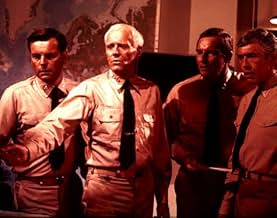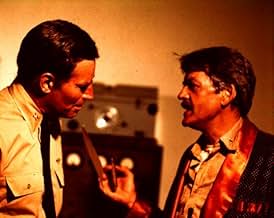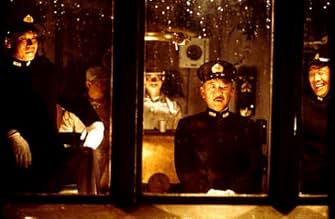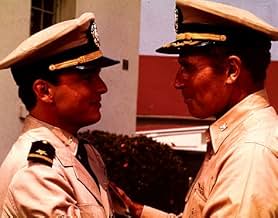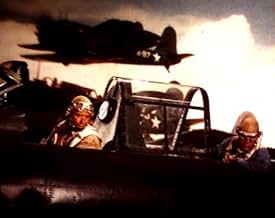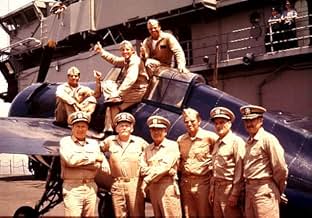NOTE IMDb
6,8/10
22 k
MA NOTE
Une dramatisation de la bataille qui fut le moment décisif du Pacifique durant la seconde guerre mondiale.Une dramatisation de la bataille qui fut le moment décisif du Pacifique durant la seconde guerre mondiale.Une dramatisation de la bataille qui fut le moment décisif du Pacifique durant la seconde guerre mondiale.
Toshirô Mifune
- Admiral Isoroku Yamamoto
- (as Toshiro Mifune)
Histoire
Le saviez-vous
- AnecdotesKevin Dobson's character Ensign George Gay, was the sole survivor of Torpedo Squadron 8. Gay wrote a book about his experiences (Sole Survivor) and was an advisor on this film.
- GaffesWhen the cockpit of one of the planes catches fire, the pilot pulls out a fire extinguisher. It is a more modern one, not a fire extinguisher that would have existed in the 1940s.
- Citations
Vice Adm. Chuichi Nagumo: [commenting on the American torpedo bombers] They sacrifice themselves like samurai, these Americans.
- Versions alternativesA television version exists, with additional cast and plot. It runs four hours with commercials. The main plot points are a Charlton Heston-Susan Sullivan romance and the Coral Sea battle (reffered to in the other version) is played out like the Midway battle. The Coral Sea battle heavily features Mitchell Ryan as Admiral Aubrey Fitch and also includes a subplot where a young Japanese pilot who'd met with Admiral Nagumo to express his opposition to Japanese military action is shot down. At the end of the TV version, Sullivan and Christine Kukobo are both shown waiting dockside.
- ConnexionsEdited from Salute to the Marines (1943)
- Bandes originalesIn the Mood
Music by Joe Garland
Performed by the Glenn Miller and His Orchestra (as Glenn Miller Orchestra) on the jukebox at the bar in Hawaii
Commentaire à la une
Saturday night TV is a bit of a dead zone down here so I suppose one should be grateful for the odd watchable movie, even if its 20 years old. This one looks older than it actually is, due to the liberal use of stock footage and a cast that's a retirement counsellor's dream. A relatively youthful Charlton Heston is in the lead, but there's Henry Fonda, Glenn Ford, Robert Mitchum, Robert Webber and even the great Japanese actor Toshiro Mifune. A curious aspect is that every military character with a speaking part is an officer; the grunts just get to grunt. It's very much the view from the bridge (and the pilot's seat). Despite this aspect and the attempt at historical realism it's not made clear quite how it was that the Japanese made the error that cost them the battle, getting caught with their flightdecks full just as the American torpedo bombers arrived. The contribution of the American land-based aircraft is also given scant recognition.
Still you do get a bit of a story, though the less said about the silly sub-plot involving the Heston character's son and a Japanese-American girl the better. The director, Jack Smight had extensive T V experience, as did many of the younger actors, and this shows up in the rather static dialogue scenes you get when you aren't allowed to move the cameras much. The Japanese voices are dubbed, so that Paul Free, the voice of Boris Badenov in "Bullwinkle," (and countless other cartoon characters) is Admiral Yamamoto. The music was written by John Williams who a year or so later did the music for "Star Wars" and you can sense the similarities.
In the film the military operations side of things abounds with anacronisms, partly due to the liberal use of stock footage as mentioned. I don't think you can be too hard on the producers (the low profile but financially successful Mirisch Brothers) for not using a real Japanese World War 2 aircraft carrier since they are all at the bottom of the sea, but the crashed jet on the Yorktown's flightdeck was a bit sloppy. "Tora Tora Tora," which cost more money, was a better film. Not because it cost more money but because it was more carefully made, more balanced (both side's story told well) and more honest, perhaps also because it dealt with defeat rather than victory from the American viewpoint. "Midway" has some suspense, plenty of action, and the the patriotism drum is not banged to the point of pain.
Still you do get a bit of a story, though the less said about the silly sub-plot involving the Heston character's son and a Japanese-American girl the better. The director, Jack Smight had extensive T V experience, as did many of the younger actors, and this shows up in the rather static dialogue scenes you get when you aren't allowed to move the cameras much. The Japanese voices are dubbed, so that Paul Free, the voice of Boris Badenov in "Bullwinkle," (and countless other cartoon characters) is Admiral Yamamoto. The music was written by John Williams who a year or so later did the music for "Star Wars" and you can sense the similarities.
In the film the military operations side of things abounds with anacronisms, partly due to the liberal use of stock footage as mentioned. I don't think you can be too hard on the producers (the low profile but financially successful Mirisch Brothers) for not using a real Japanese World War 2 aircraft carrier since they are all at the bottom of the sea, but the crashed jet on the Yorktown's flightdeck was a bit sloppy. "Tora Tora Tora," which cost more money, was a better film. Not because it cost more money but because it was more carefully made, more balanced (both side's story told well) and more honest, perhaps also because it dealt with defeat rather than victory from the American viewpoint. "Midway" has some suspense, plenty of action, and the the patriotism drum is not banged to the point of pain.
Meilleurs choix
Connectez-vous pour évaluer et suivre la liste de favoris afin de recevoir des recommandations personnalisées
- How long is Midway?Alimenté par Alexa
Détails
Box-office
- Montant brut aux États-Unis et au Canada
- 43 220 000 $US
- Week-end de sortie aux États-Unis et au Canada
- 4 356 666 $US
- 20 juin 1976
- Durée2 heures 12 minutes
- Couleur
- Rapport de forme
- 2.39 : 1
Contribuer à cette page
Suggérer une modification ou ajouter du contenu manquant

Lacune principale
By what name was La bataille de Midway (1976) officially released in India in English?
Répondre

